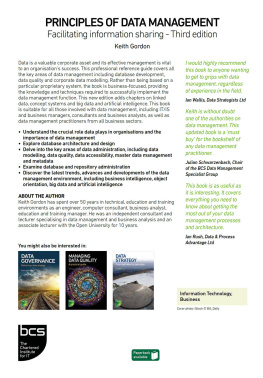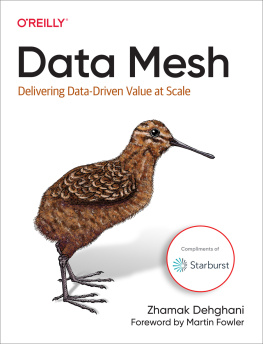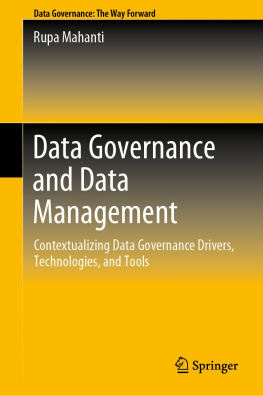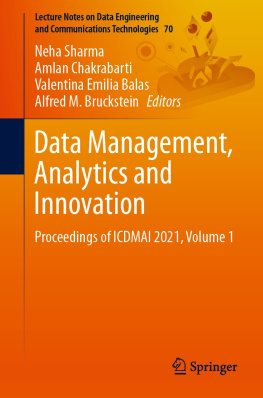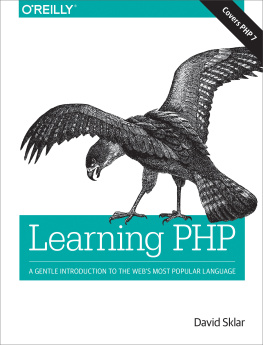Gils Bas van - Data Management: a Gentle Introduction
Here you can read online Gils Bas van - Data Management: a Gentle Introduction full text of the book (entire story) in english for free. Download pdf and epub, get meaning, cover and reviews about this ebook. year: 2020, publisher: Van Haren Publishing, genre: Romance novel. Description of the work, (preface) as well as reviews are available. Best literature library LitArk.com created for fans of good reading and offers a wide selection of genres:
Romance novel
Science fiction
Adventure
Detective
Science
History
Home and family
Prose
Art
Politics
Computer
Non-fiction
Religion
Business
Children
Humor
Choose a favorite category and find really read worthwhile books. Enjoy immersion in the world of imagination, feel the emotions of the characters or learn something new for yourself, make an fascinating discovery.
- Book:Data Management: a Gentle Introduction
- Author:
- Publisher:Van Haren Publishing
- Genre:
- Year:2020
- Rating:4 / 5
- Favourites:Add to favourites
- Your mark:
- 80
- 1
- 2
- 3
- 4
- 5
Data Management: a Gentle Introduction: summary, description and annotation
We offer to read an annotation, description, summary or preface (depends on what the author of the book "Data Management: a Gentle Introduction" wrote himself). If you haven't found the necessary information about the book — write in the comments, we will try to find it.
Data Management: a Gentle Introduction — read online for free the complete book (whole text) full work
Below is the text of the book, divided by pages. System saving the place of the last page read, allows you to conveniently read the book "Data Management: a Gentle Introduction" online for free, without having to search again every time where you left off. Put a bookmark, and you can go to the page where you finished reading at any time.
Font size:
Interval:
Bookmark:
Data Management: a gentle introduction
Van Haren Publishing (VHP) specializes in titles on Best Practices, methods and standards within four domains:
- IT and IT Management
- Architecture (Enterprise and IT)
- Business Management and
- Project Management
Van Haren Publishing is also publishing on behalf of leading organizations and companies: ASLBiSL Foundation, BRMI, CA, Centre Henri Tudor, CM Partners, Gaming Works, IACCM, IAOP, IFDC, Innovation Value Institute, IPMA-NL, ITSqc, NAF, KNVI, PMI-NL, PON, The Open Group, The SOX Institute.
Topics are (per domain):
IT and IT Management
ABC of ICT
ASL
CMMI
COBIT
e-CF
ISO/IEC 20000
ISO/IEC 27001/27002
ISPL
IT4IT
IT-CMF
IT Service CMM
ITIL
MOF
MSF
SABSA
SAF
SIAM
TRIM
VeriSM
Enterprise Architecture
ArchiMate
GEA
Novius Architectuur
Methode
TOGAF
Business Management
BABOK Guide
BiSL and BiSL Next
BRMBOKTM
BTF
CATS CM
EFQM
eSCM
IACCM
ISA-95
ISO 9000/9001
OPBOK
SixSigma
SOX
SqEME
Project Management
A4-Projectmanagement
DSDM/Atern
ICB / NCB
ISO 21500
MINCE
M_o_R
MSP
P3O
PMBOK Guide
Praxis
PRINCE2
For the latest information on VHP publications, visit our website: www.vanharen.net.

Title: | Data Management: a gentle introduction |
Subtitle: | Balancing theory and practice |
Author: | Bas van Gils, managing partner @ Strategy Alliance |
Illustrations: | Andy Lo Tam Loi |
Reviewers: | Mirjam Visscher and Tanja Glisin |
Text editor: | Lisa Gaudette and Steve Newton (Galatea) |
Publisher: | Van Haren Publishing, s-Hertogenbosch |
ISBN hard copy: | 978 94 018 0550 6 |
ISBN eBook (pdf): | 978 94 018 0552 0 |
ISBN ePUB: | 978 94 018 0555 1 |
Edition: | First edition, first impression, February 2020 |
Lay out and DTP | Coco Bookmedia, Amersfoort NL |
Copyright: | 2020 Van Haren Publishing |
Trademark notices
TOGAF and ArchiMate are registered trademarks of The Open Group. All rights reserved.
DMBOK is a registered trademark of DAMA International
All rights reserved. No part of this publication may be reproduced in any form by print, photo print, microfilm or any other means without written permission by the publisher.
Although this publication has been composed with much care, neither author, nor editor, nor publisher can accept any liability for damage caused by possible errors and/or incompleteness in this publication.
Although this publication has been composed with most care, neither author nor publisher can accept any liability for damage caused by possible errors and/or incompleteness in this publication.
No part of this publication may be reproduced in any form by print, photo print, microfilm or other means without written permission by the publisher.

I wonder if Bas van Gils had in mind the quote by Albert Einstein, that Everything should be made as simple as possible, but not simpler, because in this book you are about to read, he has created a gentle introduction which truly serves the purpose of explaining data and data management. Personally, when I first got into the world of data 20+ years ago, and coming from a background in marketing and business development, I had to learn about data management through the gradual osmosis of interacting with data professionals. While this is useful in understanding the what of real-world practice, it doesnt fill in the theoretical foundations of how and why which are necessary to understand why that real-world practice works the way it does. I know I would have come up to speed a whole lot faster, if Id had access to this book.
One of the big themes in corporate data today is dataliteracy, and as organizations strive to become more data-driven, then its a theme that will only grow in relevance. Data is not a trend thats going to flame out in a few years, so just like financial literacy and human capital management, it is now obvious that data literacy is going to be a critical knowledge requirement for all managers and executives in the future. As such, we should be thinking about data education in the same way we think about financial and HR education, building the foundations in schools and universities, then continuing to apply those foundations to practical experience through employee onboarding programs, and broader corporate training.
This book serves these objectives well. All the important enterprise-level data management topics are included. It serves as a valuable curriculum for someone just starting out in a professional data career, or indeed for someone who like me, who picked up bits and pieces without much structure to my learning. Bass explanations are clear, and build upon each other systematically. I personally appreciate the research that has gone into identifying the clearest definitions available, even when that means quoting other sources. Bas has effectively curated the best of from existing industry literature, and tied everything together into a consistent whole, through his own lucid insight, analysis and explanations.
I wish you, the reader, well whether this is the start of your data management journey, or like me, you are finding structure for your fragmented knowledge. You have found an excellent resource to help you fulfill your objectives.
Tony Shaw, CEO & Founder of Dataversity
October 2019

Language (die Sprache) is always a mediator, the famous Von Humboldt wrote 200 years ago. It is between the finite and the infinite, he continues, and at the same time between one individual and the other. In traditional philosophical categories: as a subject-object relator and a subject-subject relator. That Von Humboldt spoke using the terms finite and infinite says something about his view of the human subject (its finiteness, in several respects). It is important to note that when Von Humboldt calls language a mediator, he explicitly wants to say that the two things that get mediated do not exist independently of each other, but that in a way they come into existence through the mediation. The mediator is more than a formal relationship. That is why for him language is not a coding system where an (arbitrary) sign is determined for something that already exists for us. Such a coding system does not make language, it presupposes language.
To some extent, the characterization of Von Humboldt for language can also be applied to data, the subject of this book. Yes, the formal data structures in a computer have been designed, so as such they are not language in the Von Humboldt sense. Still, they draw on language, and so take over some of its characteristics. Data also mediates between subjects. This is one reason why data needs to be protected, as identified in of this book, and why shared understanding is a fundamental goal. It is also mediating with an infinite world around us. To use a phrase of Bas, data codifies what we know about the world. At another place, data is defined as the combination of fact and meaning. If this is true (and who am I am to question Bas?), it means that managing data has two rather different faces. Because managing facts, as stored in files on a disk, is quite different from managing such an intangible thing as meaning. I dont want to push this point too much, but I think here is one reason why data management is not simple and not comparable to the management of physical assets such as vehicles or library books, in spite of some similarities.
Next pageFont size:
Interval:
Bookmark:
Similar books «Data Management: a Gentle Introduction»
Look at similar books to Data Management: a Gentle Introduction. We have selected literature similar in name and meaning in the hope of providing readers with more options to find new, interesting, not yet read works.
Discussion, reviews of the book Data Management: a Gentle Introduction and just readers' own opinions. Leave your comments, write what you think about the work, its meaning or the main characters. Specify what exactly you liked and what you didn't like, and why you think so.




